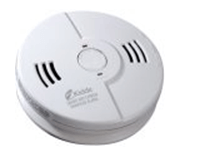Pick the right carbon monoxide alarm!
(Read this . . . it can save your life!)
Did you hear the 2021 stories about Texas families dying overnight because of carbon monoxide poisoning? Did you hear that in the middle of the 2022 winter storms, hospitals were being reminded to check incoming patients for carbon monoxide poisoning? Carbon monoxide poisoning can kill anyone. Don’t become a victim.
In California, where we live, the Senate passed the Carbon Monoxide Poisoning Prevention Act in 2011. It requires all single-family homes with an attached garage or a fossil fuel source (oil, gas, propane) to have carbon monoxide alarms within the home. Since 2013 owners of multi-family leased or rental properties have to comply with the law, too. In addition . . .
- New homes (or new construction such as a remodel) must have hardwired alarms with battery backup.
- Existing homes may have hardwired alarms with battery backup, plug-in with battery backup, or simply battery operated.
- Most importantly, alarms must be installed outside each separate sleeping area and on every level of the house.

Again, the above applies to California. Other states have different requirements; if you own or live in a rental property, you are probably required to have alarms. Check with your own state or locality to be sure you meet the latest requirements.
What is the difference between carbon monoxide alarms and carbon monoxide detectors?
A carbon monoxide alarm is a stand-alone unit. It has its own built-in power supply and audible signal. A carbon monoxide detector, in contrast, is part of a fire alarm system and gets its power from the fire alarm. Further, there are battery-operated combination smoke/CO alarms.
(If you are a professional home inspector or simply a very concerned consumer, you can use a carbon monoxide detection METER to measure levels within your home. Don’t confuse a carbon monoxide meter with a natural gas detector or sniffer — different gases altogether! Here’s more on the topic of natural gas sniffers! )
All these devices must meet certain UL (Underwriters Laboratory) standards in order to be sold.
What is the role of batteries in these devices?
- The batteries in a hardwired CO alarm are meant to provide protection in the event of a power outage. If you don’t have power outages, your batteries won’t be called into play. But they will still wear out over time. If you intend to get a hardwired version, check on the type and size of battery and how long it is expected to last.
- All battery-operated devices have a finite life-span, and are assumed to come to the end at some point. Check on life-span. Even if you replace the batteries, the alarm itself may come to the end of its useful life — which may range from 5 to 10 years.
- In any case, check on the date of manufacture and get the newest device possible. (And read consumer reviews about how hard it is to replace batteries. Some models get complaints about the battery doors not closing properly.)
The life of a CO alarm is considered to be 7 years. Since 2009, your alarm will have an END-OF-LIFE signal — 30-second beeps that won’t stop, and a message on the screen. Replace that alarm!
If your CO alarm is 10 years old, no matter how carefully you’ve treated it — throw it out and get a new one!
Check the different features of the models shown below. Look for power type, display, and audible warning. Consumer reporting agencies give all these excellent ratings. Prices range from a low of around $15 to a high of about $40. If you click on the image or on the link you will be taken to Amazon, where we are associates. Be sure to take the time to compare prices there — sometimes the same item is for sale at two or three different prices!
If you can’t decide which one to get, get two! The worst thing you can do is fail to act at all.
 | Plug-Ins are easiest to use. Press the button to get a digital readout of CO levels. First Alert CO615 Carbon Monoxide Plug-In Alarm with Battery Backup and Digital Display |
 | A plug-in that provides a continuous display updated every 15 seconds. Kidde KN-COPP-3 Nighthawk Plug-In Carbon Monoxide Alarm with Battery Backup and Digital Display |
 | Battery-operated can be placed anywhere. Sounds horn when dangerous levels are reached. The simplest, smallest and most popular model. This is the two-pack. First Alert CO400 Battery Powered Carbon Monoxide Alarm, 2-Pack |
 | Combination model smoke and CO alarm, issues verbal warning: "Fire! Fire!" and "Warning! Carbon monoxide!" Also has a low-battery alert and Hush Mode for silencing the smoke alarm. Kidde Battery-Operated(Not Hardwired) Combination Smoke/Carbon Monoxide Alarm with Voice Warning KN-COSM-BA Model Kidde KN-COSM-1B is the hard-wired version of the Kidde combination alarm described above. Kidde KN-COSM-IBA Hardwire Combination Smoke/Carbon Monoxide Alarm with Battery Backup and Voice Warning, Interconnectable |
